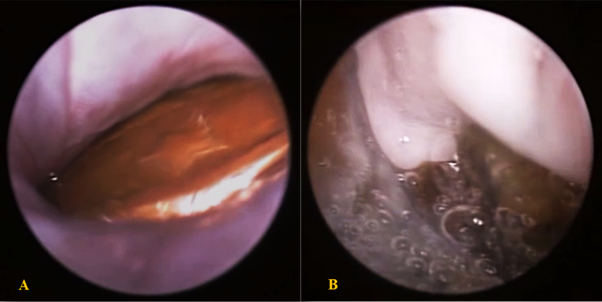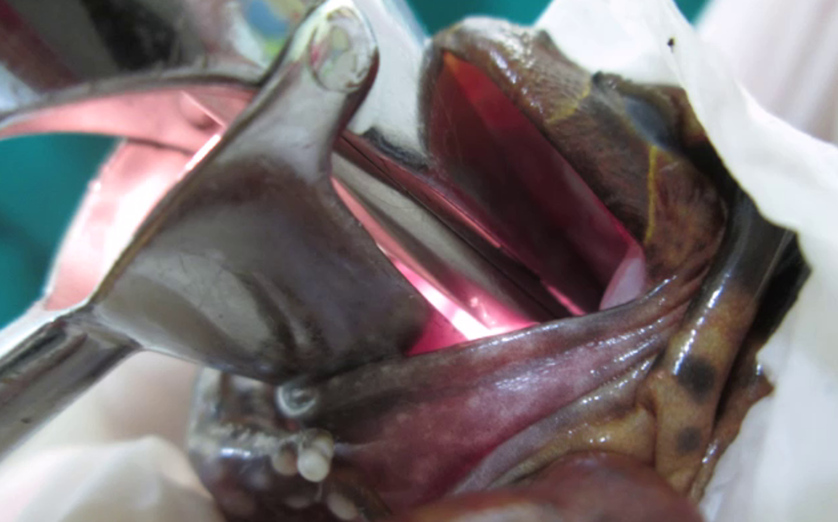Case Report
Volume 1 Issue 2 - 2017
Copper Coin Gastric Foreign Body Extraction in A Tomato Frog
1Centro Veterinario per Animali Esotici, Palermo, Italy
2Avian and Exotic Animal Clinic, Faculty of Veterinary Medicine, University of Veterinary and Pharmaceutical Sci-ence, Brno, Czech Republic
3Safari Park, Pombia, Novara, Italy
2Avian and Exotic Animal Clinic, Faculty of Veterinary Medicine, University of Veterinary and Pharmaceutical Sci-ence, Brno, Czech Republic
3Safari Park, Pombia, Novara, Italy
*Corresponding Author: Di Giuseppe Marco, Centro Veterinario per Animali Esotici, Palermo, Italy.
Received: May 23, 2017; Published: July 03, 2017
Abstract
An adult male tomato frog (Dyscophus guineti), 0.044 kg body weight, was presented with lethargy and suspect ingestion of a copper pleated coin. Physical examination and radiography revealed a presence of rounded radio-paque foreign body object. With the use of rigid endoscope the foreign body was seen in the stomach, but due to accumulation of oesophageal mucus the possibility of safe extraction was impossible. Vaginoscope speculum attached to the otoscope was used to visualize the foreign body extraction. Hartmann forceps, inserted through the vaginoscope working channel was used for the coin extraction. The recovery was uneventful and the frog was fully active within one week. One week after gastroscopy the patient started to feed spontaneously. The non-invasive method should be preferred to coeliotomy whenever the foreign body is directly visible in amphibian stomach.
Keywords: Amphibians; Anurans; Alfaxalone; Gastroscopy; Foreign body
Introduction
Foreign body ingestion is a common medical problem in amphibian medicine (Stetter 1995; Wright and Whitaker 2001b; Clayton 2005). Stones, grit, gravel or terrarium substrates are commonly found during routine examina-tion of the amphibian patient. Smaller material may pass without issues. However larger objects may cause rup-ture of the gastric mucosa, and intestinal impaction. Lethargy, vomiting, and abdominal bloating are common symptoms. Abdominal palpation frequently reveals a firm mass. The use of gastroscopy showed to be effective in foreign body extraction (Boggs and Theisen 1997; Wright and Whitaker 2001a; Bertelsen and Crawshaw 2005). The big mouth cavity and relatively short oesophagus make the gastroscopy in frogs easy to accomplish (Wright 2001a; Chai 2015). In failure of the gastroscopy, the surgeon must considered coeliotomy and gastrotomy (Wright 2001b; Clayton and Gore 2007; Chai 2014).
Clinical Case
An adult male tomato frog (Dyscophus guineti), 0.044 kg body weight, was presented with suspect ingestion of a foreign body. According to the owner, the animal swallowed a coin and started to vomit immediately, however the coin was not expelled. Physical examination revealed a frog in a good body condition. Neurological examina-tion showed lethargy, but reflexes (withdrawal reflex, righting reflex, and eyelid blink reflex) were present. Palpa-tion of the abdomen revealed a firm rounded object. Using the trans-illumination of the abdomen with a lamp, the foreign body was visualized. A dorso-ventral (DV) radiogram confirmed the presence of a round, radiopaque for-eign body (Figure 1). The foreign body extraction was scheduled. The frog was anaesthetized with Alfaxalone (10 mg/kg, Alfaxan®, Vétoquinol, France) administered intramuscularly. Five minutes later the mouth was opened using a lingual spatula. For a better visualization of the mucosa, the stomach was gently flushed with saline (0,9% NaCl, SALF, Italy). Rigid endoscope (30°, 2.7 mm, 18 cm length, Karl Storz, Germany) with a 3.5 mm work-ing sheath and videocamera (Telecam SL Video Camera System 20212120, Karl Storz Germany), were used for gastroscopy. The coin was seen in the stomach (Figure 2), but oesophageal mucus strongly limited the possibil-ity of safe visual control of its extraction. Vaginoscope speculum (Gima, Italy) attached to the otoscope was therefore used to visualize the foreign body extraction. Hartmann forceps, inserted through the vaginoscope working channel was used for the coin extraction (Figure 3). The recovery was uneventful and the frog was fully active within one week. The patient did not vomit and no symptoms of gastric disease were present. Post-surgical treatment included 5 days of orally administration of meloxicam (0.4 mg/kg, q24h, Metacam Boehringer Ingelheim, Germany) and enrofloxacin (10 mg/kg, q24h Baytril 2.5%, Bayer, Germany) for. One week after gas-troscopy the patient started to feed spontaneously.
An adult male tomato frog (Dyscophus guineti), 0.044 kg body weight, was presented with suspect ingestion of a foreign body. According to the owner, the animal swallowed a coin and started to vomit immediately, however the coin was not expelled. Physical examination revealed a frog in a good body condition. Neurological examina-tion showed lethargy, but reflexes (withdrawal reflex, righting reflex, and eyelid blink reflex) were present. Palpa-tion of the abdomen revealed a firm rounded object. Using the trans-illumination of the abdomen with a lamp, the foreign body was visualized. A dorso-ventral (DV) radiogram confirmed the presence of a round, radiopaque for-eign body (Figure 1). The foreign body extraction was scheduled. The frog was anaesthetized with Alfaxalone (10 mg/kg, Alfaxan®, Vétoquinol, France) administered intramuscularly. Five minutes later the mouth was opened using a lingual spatula. For a better visualization of the mucosa, the stomach was gently flushed with saline (0,9% NaCl, SALF, Italy). Rigid endoscope (30°, 2.7 mm, 18 cm length, Karl Storz, Germany) with a 3.5 mm work-ing sheath and videocamera (Telecam SL Video Camera System 20212120, Karl Storz Germany), were used for gastroscopy. The coin was seen in the stomach (Figure 2), but oesophageal mucus strongly limited the possibil-ity of safe visual control of its extraction. Vaginoscope speculum (Gima, Italy) attached to the otoscope was therefore used to visualize the foreign body extraction. Hartmann forceps, inserted through the vaginoscope working channel was used for the coin extraction (Figure 3). The recovery was uneventful and the frog was fully active within one week. The patient did not vomit and no symptoms of gastric disease were present. Post-surgical treatment included 5 days of orally administration of meloxicam (0.4 mg/kg, q24h, Metacam Boehringer Ingelheim, Germany) and enrofloxacin (10 mg/kg, q24h Baytril 2.5%, Bayer, Germany) for. One week after gas-troscopy the patient started to feed spontaneously.

Figure 1: Tomato frog (Dyscophus guineti). Dorso-ventral (DV) radiogram
revealed the presence of a round, radiopaque foreign body.

Figure 2: Gastroscopy of tomato frog (Dyscophus guineti). A. The coin is clearly seen in the stomach.
B. Oesophageal mucus and gastric contents strongly limited the vision through the optic.

Figure 3: Vaginoscope speculum attached to the otoscope was used
to visualize the foreign body extraction.
Discussion and Conclusion
Vomiting and gastric prolapse are a common complications of the foreign bodies ingestion in frogs (Clayton 2005; Clayton 2007). Depending on the location and size of the ingested items, a number of treatment options are available for the gastroscopy in amphibians. The digestive tract of amphibians is short and simple. Food is usually swallowed and chewing has been reported only in a few species (Reeder 1964). Amphibian’s oral cavity is separated from the esophagus by a strong sphincter, as the esophagus is separated from the stomach by the cardias. Visualization of the sphincter can be difficult, due to the presence of thick mucus, secreted by oral, esophageal and gastric epithelial glands. Abundant production of mucus is meant to allow the passage of big prey items (O’Malley 2005), and to protect the mucosa from injuries produced by a moving prey. Retrieving items through the oropharynx using fingers or alligator forceps would be possible, but the ingested items should not be forced out and the gastric wall may be damaged during the procedure. By performing a gentle warmed saline flushing, foreign body could be displaced, but oesophageal mucus strongly limited the possibility of safe coin extraction in the tomato frog. The sphincter between the oesophagus and the stomach has a strong muscle tone and ingested items may cause compression of the abdominal wall and irritation of the mucosal membrane. The great elasticity of the frog oral cavity allows the safe use of the vaginal speculum for clear visual control of the stomach content and easy gastroscopy procedure (Di Giuseppe., et al. 2015). The non-invasive method should be preferred to coeliotomy whenever the foreign body is directly visible in amphibian stomach.
References
- Bertelsen M and Crawshaw G. “5-Minute guide to amphibian diseas”. Exotic DVM 5.2 (2005): 23-26.
- Boggs L and Theisen S. “Endoscopic removal of gastric foreign bodies in an African bullfrog, Pyxicephalus adspersus”. Newsl Assoc Reptilian Amphib 7.2 (1997): 7-8.
- M Fowler and R Miller. “Zoo and wild animal medicine. 8th edition”. W.B. Saunders, St Louis, MO. pp 1-13.
- Chai N. “Endoscopy in Amphibians”. Veterinary Clinics of North America: Exotic Animal Practice 18.3 (2015): 479-491.
- Clayton LA and Gore SR. “Amphibian Emergency Medicine”. Veterinary Clinics of North America: Exotic Animal Practice 10.2 (2007): 587-620.
- Clayton LA. “Amphibian Gastroenterology”. Veterinary Clinics of North America: Exotic Animal Practice 8.2 (2005): 227-245.
- Di Giuseppe., et al. “An alternative way to perform gastroscopy in large frogs and toads”. Journal of Small Animal Practice 57.2 (2015): 110.
- O'Malley B. “Amphibians. In: Clinical Anatomy and Physiology of Exotic Species. Ed. B. O’Malley”. W.B. Saunders, St Louis, MO (2005): pp 3-14.
- Reeder W.G. “The digestive system. In: Physiology of the amphibian. Ed J.A. Moore”. Academic Press, New York, NY. (1964): pp 99 149.
- Stetter MD. “Noninfectious Medical Disorders of Amphibians”. Seminars in Avian and Exotic Pet Medicine 4.1 (1995): 49-55.
- Wright KM and Whitaker BR. (2001a) Clinical techniques. In: Amphibian Medicine and Captive Husbandry. K.M. Wright and B.R. Whitaker B.R. Krieger Publishing Company, Malabar, FL, pp 89-109.
- Wright KM and Whitaker BR. (2001b) Nutritional disorder. In: Amphibian Medicine and Captive Husbandry. K.M. Wright and B.R. Whitaker BR. Krieger Publishing Company, Malabar, FL, pp, 73-87.
- Wright KM. (2001a) Anatomy for the Clinician. In: Amphibian Medicine and Captive Husbandry. K.M. Wright and B.R. Whitaker B.R. Krieger Publishing Company, Malabar, FL, pp, 15-30.
- Wright, K.M. (2001b) surgical techniques. In: Amphibian Medicine and Captive Husbandry. K.M. Wright and B.R. Whitaker B.R. Krieger Publishing Company, Malabar, FL, pp 273-283.
Citation:
Di Giuseppe Marco., et al. “Copper Coin Gastric Foreign Body Extraction in A Tomato Frog”. Multidisciplinary Advances in
Veterinary Science 1.2 (2017): 73-76.
Copyright: © 2017 Di Giuseppe Marco., et al. This is an open-access article distributed under the terms of the Creative Commons Attribution License, which permits unrestricted use, distribution, and reproduction in any medium, provided the original author and source are credited.





























 Scientia Ricerca is licensed and content of this site is available under a Creative Commons Attribution 4.0 International License.
Scientia Ricerca is licensed and content of this site is available under a Creative Commons Attribution 4.0 International License.